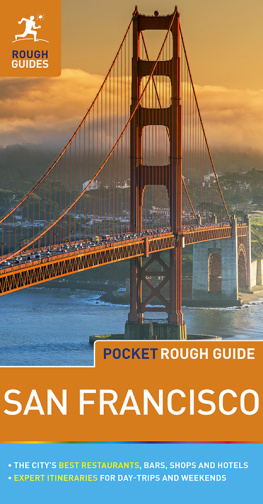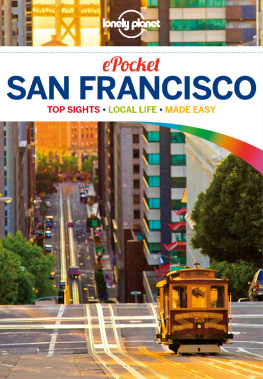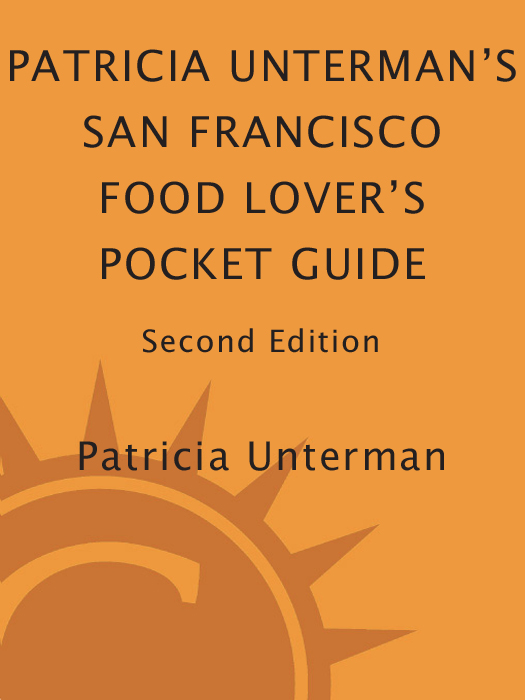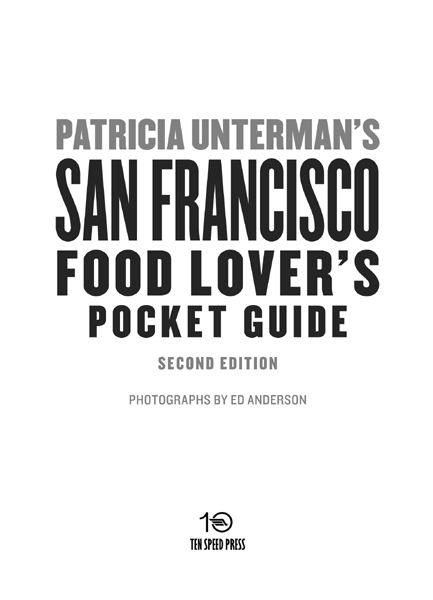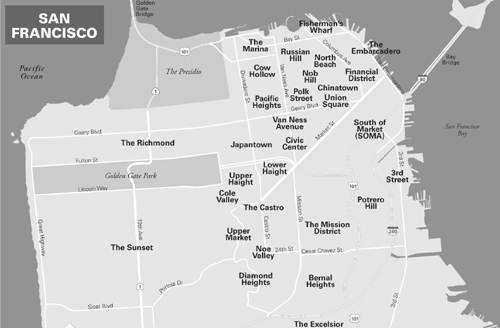Special thanks for this second edition of the pocket guide go to extraordinarily smart and diligent fact-checker Margot Kenney; incomparable editor and alter ego Paula Tevis; Ten Speed editor Melissa Moore; and Ed Anderson, designer extraordinaire. Thanks also to Lorena Jones who initiated the project and came up with a very good idea. Without Tim Savinar, companion, booze hound, and daily copy editor, nothing would be possible.
Copyright 2007, 2009 by Patricia Unterman
Photographs copyright 2005, 2007 by Ed Anderson
All rights reserved.
Published in the United States by Ten Speed Press, an imprint of the Crown Publishing Group, a division of Random House, Inc., New York.
www.crownpublishing.com
www.tenspeed.com
Ten Speed Press and the Ten Speed Press colophon are registered trademarks of Random House, Inc.
Library of Congress Cataloging-in-Publication Data is on file with the publisher.
eISBN: 978-0-307-78410-0
v3.1
CONTENTS
THE NEIGHBORHOODS
OUT OF TOWN
INTRODUCTION
The San Francisco Food Lovers Guide was written both for visitors and for residents who want to explore the culinary landscape of their own city. The new pocket edition, fully updated, with shortened entries and a convenient size for purse, glove compartment, or backpack, means that my comprehensive and opinionated restaurant and food guide can always be handy.
For over three decades, I have been developing my sense of taste as a restaurant critic (at the San Francisco Chronicle and the San Francisco Examiner), and as a cook both at home and in San Francisco at the Hayes Street Grill, which I own with my partner of thirty years, Richard Sander. But what I really am is an eater, someone who loves food of every kind, but with an almost obsessive discrimination. Such openness combined with unrelenting critical consciousness seems like a paradox; being a connoisseur suggests a narrowing of taste. But eating something gorgeous, humble or high as it may be, floods me with pleasure and expands my consciousness. Looking for sensuous food has been an unending quest. I admit it: eating is the center of my intellectual and emotional life. It sounds frivolous, but as far as I can see, the better the food, the happier the person, if only for a moment. My idea of an evolved world pretty much hinges on wanting all people to have access to a good meal when they are hungry.
San Francisco is a culinary crossroads where ethnic cooks and ingredients, especially from Asia and Latin America, enrich our own indigenous products and cooking style. The mild Northern California climate supports an enormous variety of fruits, vegetables, and herbs. Our location on the edge of the Pacific ensures a supply of fresh seafood. The cool fog and protected hills and valleys make for a now world-class wine country. But even more interesting is the continual increase of artisanal producers. We have a vital organic farming movement here that not only yields fruits and vegetables, but also meat, poultry, and dairy, plus an efficient distribution system that delivers these foods to consumers, sometimes on the morning theyve been harvested, at our many farmers markets. Furthermore, the Bay Area has become a large enough market to support imports from all over the world. The products we dont make ourselves, we ship in. This bounty attracts an ever-more-sophisticated food community and an influx of people who come here to eat, work, and live within it. San Franciscans never feel culinarily bereft coming home after a trip. They have too many pleasures right here.
ABOUT THE CATEGORIES

The book is divided into chapters that explore loosely drawn neighborhoods in the city, plus some important centers of good eating outside the city. Although not every one of the following categories is represented in every chapter, restaurants always are because they, more than any other culinary institution, excite and entertain us.
RESTAURANTS

Each chapter starts with a very personal selection of restaurants that I have enjoyed over the years for one reason or another. Sometimes a restaurant is included because it makes one dish I adore, or because it provides a useful service to its neighborhood, or because it feels good to be sitting in it. A very few have been included because of the importance of their role in the citys dining-out profile (though not necessarily mine), and I felt I had to say a few words about them. Youll just have to read the entries.
There are so many restaurants in the city now that you almost dont need to reserve in advance, especially if you go at a slightly off hour. The weekends can be tougher at the most popular dinner houses, but it never hurts to drop by if you can be flexible. The American appetite tends to be spontaneous, and many restaurants cater to this free-spirited dining by serving at the bar, at cocktail tables, and at counters. You can get a good taste of expensive restaurants inexpensively by ordering a glass of wine and a few appetizers from a perch at the bar.
CAFES

You can always get something to eat in coffeehouses in San Francisco, but the food service is usually informal, requiring you to order at a counter. Some cafes put out stunning snacks, sandwiches, and light fare, but the draw of cafes is that you can sit, think, talk, write, or read over a beautifully made cup of coffee.
BARS

The Bay Area mixologist has taken on the role of creative chef, concocting seasonal cocktails with house-made syrups and infusions. These drinks certainly belong in a food lovers guide. But an old-school guy like my husband also considers an ice-cold martini, or a perfectly balanced margarita swirled in ice and served up, as important sustenance. Many bars do serve food, but they are included in this category for their watering-hole identitiestheir drink making, not their kitchens. Also included in this category are proliferating wine bars.
DELICATESSENS/TAKEOUT

With more and more members of the household working, and little time left for shopping and cooking, a good delicatessen or takeout can be a godsend. The best, no matter what their ethnic origins, prepare or import foods that are difficult to make at home, even if you had the time. Delicatessens also sell food to eat on the spot, though usually there are no places in the stores to sit.


